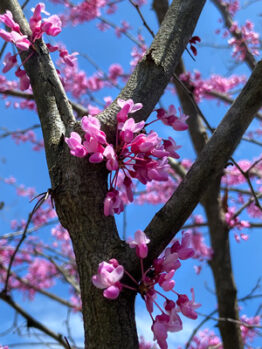Eastern Redbud
Researched by Reilly Dillon
 Species: Cercis canadensis
Species: Cercis canadensis
Common name: Eastern Redbud
Family: Fabaceae (Legume Family)
Clade: Angiosperms (flowering seed plants)
Coordinates: 39.70581725, -75.1200394
A tag using this number is placed near the tree.
Cercis canadensis, more commonly known as eastern redbud, belongs to the Fabaceae, or legume family, and is native throughout woodland areas along the East Coast, from New Jersey to Florida and across to Texas. These trees are often small and multi-stemmed, so they are popular native trees for urban and suburban landscapes.
Eastern redbuds are angiosperms, meaning they produce flowers and fruits. In the case of the eastern redbud, its fruits are legumes, similar to peas and beans. The tree’s flat pod fruits are approximately three inches long, ripen around October, and can survive through winter. The pods and the pink flowers the tree produces are safe to eat.
The eastern redbud’s bark is unique for a few reasons. It is hardwood and very dense, with a reddish inner bark. Young trees are smoother and have a brownish-grey color, while older trees tend to have more of a scale-like texture. The bark can be used for medical purposes. It has high levels of tannin, a bactericide that fights infection, and it has been used to fight coughs, colds, fevers, and even influenza. Read More
Campus Species Map
Researcher’s Biography
 Reilly Dillon
Reilly Dillon
Reilly Dillon earned a Bachelor of Science in Biological Sciences and an undergraduate certificate in counterterrorism in 2022.
Suggested Citation:
Dillon, Reilly. (2022, Dec). Eastern Redbud. Rowan University Arboretum. Glassboro, NJ. https://arboretum.rowan.edu/trees/eastern-redbud/
Questions to Explore
- How effective is the tannin molecule within the bark, and how does it compare to other forms of tannins?
- What are the different reproductive ways of the Eastern redbud? Are there any complications when pollinating on the same flower compared to pollinating on a different tree?
- Is it possible for the Eastern Redbud to have too many Rhizobium bacteria on its roots? If so, then how much would it take before it becomes harmful?
References
Bernheim, I. (2019) “Eastern redbud” Bernheim Arboretum and Research Forest: | Link
Bryant, A. (2019) “Wild Edible Wednesday 3/27 – Eastern Redbud” SARCRAFT: | Link
Dickson, J. (2022) “Eastern Redbud” USDA: | Link
Gorsira, B., Risenhoover, KL. (1994) An evaluation of woodland reclamation on strip-mined lands in east Texas. Environmental management. 18(5):787-793. | Link
Meyer, E. (2022) “Cercis canadensis” North Carolina State University: | Link
Seiler, J., Jensen, E., Niemiera, A., Peterson, J. (2021) “eastern redbud” Virginia Tech Dendrology: | Link
Rowan University Resources
You may need to log into the Rowan University Library’s website.
Inheritance and allelism of morphological traits in eastern redbud | Link
Edible and Useful Plants of the Southwest: Texas, New Mexico, and Arizona | Link
Legumes of the great plains: an illustrated guide | Link




















